George McLachlan and the 1936 overseas tour
George McLachlan will always be best remembered as a player with F.A. Cup winning Cardiff City. He then became club captain at Manchester United before managing Queen of the South over one of the most colourful and exotic chapters in the club’s history.
The original version of this article has been updated in July 2014 thanks to input from George McLachlan`s son, Robert.

Early years
Born in Glasgow in September 1902, George Hardie McLachlan joined Celtic as a junior from Crosshill Amateurs. McLachlan stayed at Celtic Park for only two weeks before joining Clyde. McLachlan spent three years with the then Shawfield club interrupted by a short loan spell at King’s Park Strollers. The speedy left winger was then transferred for a fee of £2,000 in 1925.
Cardiff City
The Bluebirds had been promoted to England’s top division in 1921. In 1923/24 they contested a stunningly close league title race with a Huddersfield Town side managed by one of the most successful managers in the history of English football, Herbert Chapman. Playing for Cardiff that season were some of the greatest names in the club’s history. Jimmy Nelson was among the finest full backs of the time (Nelson later joined the likes of Hughie Gallacher, Alex James and Alex Jackson as ‘Wembley Wizards’ in 1928 when Scotland beat England 5-1 at the twin towers). Len Davies is in the history books as Cardiff’s all time record scorer with 148 strikes. In local boy Fred Keenor’s fearless and uncompromising tackling they had the heart and soul of the side.
Going into the last game of the season Cardiff needed to beat Birmingham City to lift the title. Late in the game they were awarded a penalty. Davies took the spot kick and watched it being saved by keeper, Dan Tremelling. The game ended scoreless. Huddersfield won their game 3-0 at home to Nottingham Forest. If the league had been played with either of the goal difference or goals scored rules that we are familiar with today – the trophy would have gone to Ninian Park. Instead by what is still the narrowest margin of victory in the history of English football - a goal average of 0.024 goals – the title became the first of three consecutive English league titles won by Huddersfield Town.
Further disappointment came when in sight of silverware the season after when the Welsh side went down to Sheffield United 1-0 in the 1925 F.A. Cup final.
George McLachlan joined the season after in November 1925 when clearly they were a side to be reckoned with. However they had yet to prove they had what it takes to justify adding a bottle of metal polish to the club expenses. Many sides were interested in signing McLachlan. One article (by the BBC), states that helping his decision to go to Cardiff was his father’s occupation working on a ship that regularly dropped anchor at Cardiff Docks. However Robert McLachan tells us:
“Dad`s father was not a seaman but, I believe, a “gaffer” at Babcock & Wilcox where dad was later employed. There was a seafaring connection in the family however via my mother`s father who was a ship`s steward for many years.”
In the FA Cup in McLachlan’s first season, Cardiff were paired in January 1926 to play Newcastle United at Ninian Park. One of McLachlan’s opponents that day was another recent arrival from Scotland, Hughie Gallacher. Newcastle progressed 2-0 with Stan Seymour scoring both.
Much to McLachlan’s disappointment he missed out on an international cap in 1926 after a broken leg against Leicester City.
The high point of McLachlan’s career came with Cardiff City in 1927. With Nelson, Keenor and Davies and also the prolific Scot Hughie Ferguson, McLachlan was part of the Welsh side’s FA Cup run in 1927.
Entering the competition at the third round Aston Villa were seen off 2-1. McLachlan found the net in the 4th round 2-0 win away to Darlington. Next it was Bolton Wanderers away with an addition to the squad – a black cat called Trixie who had been adopted after having been found wandering astray at Birkdale golf course; Ferguson said the moggie would bring good luck. 3-0 saw Cardiff through again. A 6th round tie against David Calderhead managed Chelsea saw a crowd of 70 000 sardined in to Stamford Bridge
Willie Ferguson played for Chelsea in a scoreless draw before a rollercoaster replay at Ninian Park. Another monster crowd (over 47 000) saw the Welsh side take a 2-0 lead. By early in the second half the Londoners had battled back to 2-2. With another draw on the cards the game again swung Cardiff’s way thanks to Hughie Ferguson’s spot kick; 3-2 final score. In the semi Reading were beaten by three goals without reply.
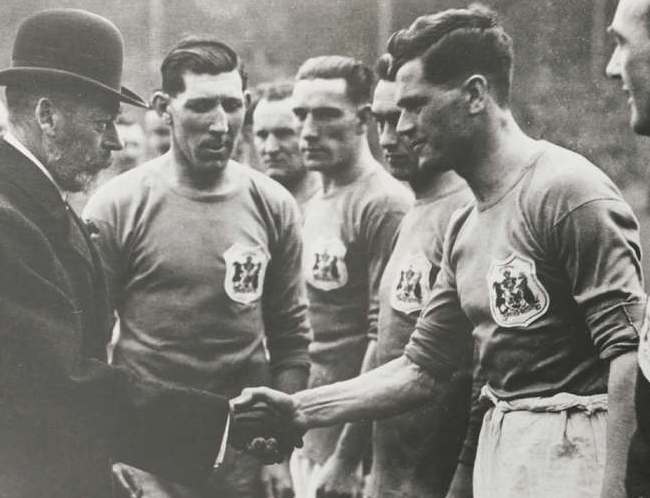
(The individual in the bowler had a park in Dumfries bear his name, King George V. The player introducing McLachlan is Cardiff captain, Fred Keenor)
And so to the final. As the first final broadcast live on BBC radio, commentators used a grid in the radio times to describe the match action. It has been claimed (not entirely convincingly) that this is where the English language was given the phrase, ‘Back to square one’ (square one was the area nearest to one of the goals). Among the crowd was a man who had steered the UK through a world war as Prime Minister, David Lloyd George. Winston Churchill was also in the crowd unaware that he was destined to do the same.
Red hot favourites Arsenal were in the process of building the side that would go on to dominate English football in the early and mid 30s. The manager of the Gunners – Herbert Chapman. Included in Chapman’s line up were Englishmen Tom Parker, Joe Hulme and Charlie Buchan, Scotsman Billy Blyth and two Welshmen, Bob John and goalie Dan Lewis.
The 90 minutes on the field are seemingly universally remembered for 1 event. In the 74th minute McLachlan gave the ball to Hughie Ferguson just inside the box. Ferguson elected to go for goal. Lewis went to gather the ball but from his fumble the ball slipped under his body. With the threat of Davies following up, Lewis tried to recover the position. Sadly lacking the dexterity of Trixie, Lewis only succeeded in elbowing the ball over the line. Final score; Arsenal 0, Cardiff City 1.
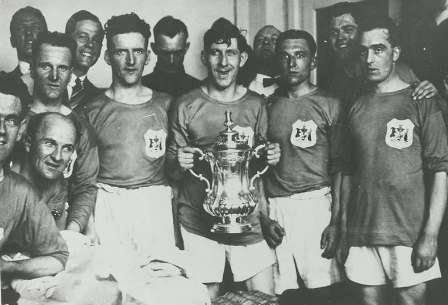
(McLachlan is the smiling figure at the far right of the back row)
With a Welsh side taking the trophy due to a blunder from a Welsh opposing goalie conspiracy enthusiasts were rejoicing with delight. Lewis claimed because his jersey was brand new it was greasy, thus he said hindering him in taking the ball’s possession. Ever since Arsenal have adopted a policy of washing the keeper’s jersey before every game – brand new or otherwise. In Cardiff, for 11 players it was sporting immortality. Jimmy Nelson again picked up a winners medal with a cup final victory versus Arsenal when in 1932 Newcastle lifted the trophy with Tommy Lang in the side – Tommy Lang of the QoS team that finished 6th in Scotland’s top flight in 1939.
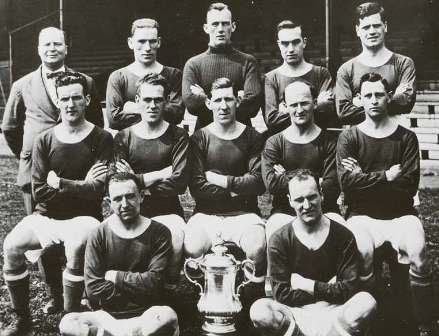
(McLachlan is again at the far right of the back row)
The season after Cardiff won the Charity Shield beating The Corinthians 2-1 at Stamford Bridge. In the league, goals from McLachlan and Nelson gave the Welsh club a 2-1 win against Liverpool at Anfield. Having led the league for a brief spell mid-season, Cardiff finished 6th.
At Cardiff City George McLachlan moved from outside-left to wing half. He played 139 league games hitting 22 goals. While at Cardiff in 1928 he played for the Anglo-Scots against the Home-Scots in an international trial match at Firhill.
Manchester United
McLachlan left the Bluebirds in December 1929 for Manchester United where he was club captain for part of his three and a half years at Old Trafford. McLachlan scored four goals in 116 games for the red devils.
Chester City
Chester City had joined the English Football League in August 1931. In June 1933 McLachlan joined as player coach.
Le Havre
McLachlan had a spell with French side Le Havre AC in season 1934-35 and was offered a further contract with the club. However his ambition was to manage a Scottish top division side.
Queen of the South
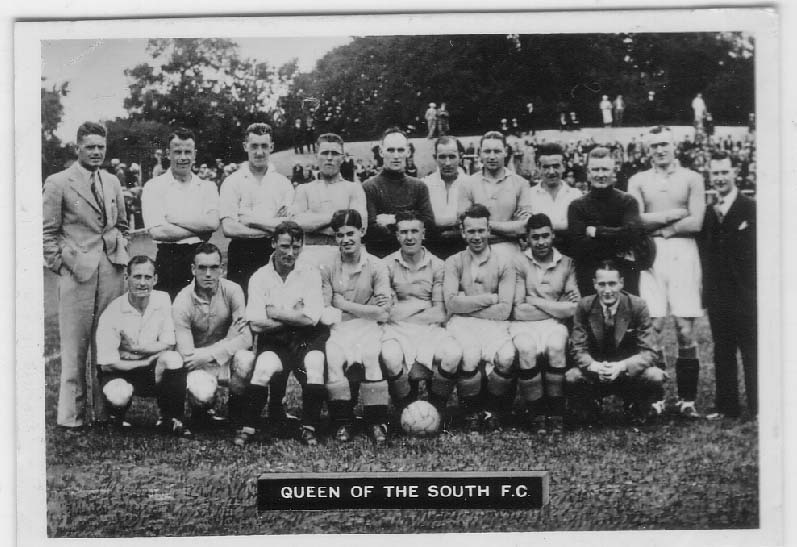
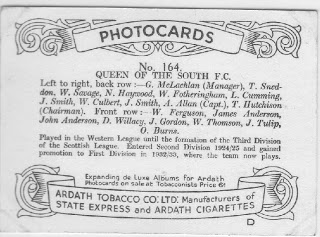
On 29th June 1935 George McLachlan was announced as the new manager of Queen of the South. He brought with him a background as cosmopolitan as anyone in the game at the time; a born and bred Scot, a legend in Wales, an ex Manchester United club captain in England and with enough French connections to rival Gene Hackman. While never threatening the heights of two seasons before when QoS finished fourth in the top division, QoS retained top flight status in 1935-36 (as they would until 1959 bar one season). At the season’s end it was time for boats, trains and automobiles as QoS set off for France to start an 11 game overseas tour.
.jpg)
(QoS squad photo on the 1936 overseas tour. Back - Haywood, Tulip, Savage, Steel [chairman].
Middle - W. Anderson, Culbert, Ferguson, Gordon, Kerr [trainer].
Front - Smith, McLachlan [manager], Cumming, Thomson, J. Anderson)
The intrepid group of Michael Palins, consisting of 16 players plus non playing staff, set off on May 4th on the overnight train to London. Overseas football experience among the players was limited to Irish international Laurie Cumming, Willie Ferguson with his decade of experience at Chelsea and Willie Fotheringham had toured Spain in 1923 along with ex-QoS Dave Halliday at Dundee. After the channel crossing to France the first game was in Bethune against Stade Béthunois.
A Norrie Haywood double and a Laurie Cumming goal put the Doonhamers seemingly in cruise control at 3-1 up. That proved to be nonsense as a second goal for the French side sparked a late fight back – their three goals in the last 15 minutes gave a 4-3 victory for the French side.
Next up, a fixture that on paper looked tough. FC Sète won the French cup in 1930 and in 1934 became the first French side to win the league and cup double (they would round the decade off with a second league title in 1939). A close fought contest saw the French team take the lead 10 minutes into the second half. QoS hit back when the Northumbrian Joe Tulip shot against the bar before the loose ball was put away by Jackie Gordon. Tulip himself then got on the score sheet to give QoS a 2-1 victory. The French hosts graciously presented a trophy to their guests as well as generous applause for the victory.
The next game again looked a possible toughie, French Cup runners up OFC Charleville, beaten by Racing Club Paris in the final. On the playing staff of the hosts was Julien Darui, who in 1999 was voted best French goalkeeper of the century by L’Équipe newspaper. The defensive tactics of the Ardennes club were epitomised by the club captain who gave the world Catenaccio when he later managed Inter Milan to three European Cup finals in four seasons, Helenio Herrera.
We can only wonder at the negative fare dished up to the home fans every fortnight. We can only try to imagine what they wondered on the way home from the QoS game having watched their heroes being given a 5-0 gubbing. Gordon hit a hat trick, Cumming a double.
Buoyed by such a result the next game was against Sporting Club Anichois but pitch conditions produced a disappointing game. The Aniche team took the lead after 20 minutes. Willie Thomson equalised five minutes later. In the second half Thomson’s free kick and Willie Ferguson’s crosses giving two headed goals for Cumming rounded off the scoring. McLachlan wrote in a letter to the Herald and Courier, “There was a trace of staleness about Queen’s play in the game against Anichois, but we were never stretched and won more easily than the score indicates”. Confident stuff from McLachlan.
A different kind of challenge was served up by the next opponents, US Boulonnais as the Boulogne side were then named, the club who recently gave the world Franck Riberry. The physical style of the hosts led them to take the lead. QoS though battled back with a rocket drive from Ollie Burns and held on for a 1-1 draw.
The next game saw the QoS entourage having to produce their passports again to get there. For the first of three consecutive games against non French opposition, the opposition was CA Spora Luxembourg (in 2005 Spora were part of a three club merger to form Racing FC Union Luxembourg). At the time Luxembourg club football was a 2 horse race for the trophies and the other teams merely also rans. Spora were one of the big two. Their greatest result came later in the 1956/57 European Cup when after losing 4-3 away to Borussia Dortmund they won 2-1 at home. In the age before the away goals rule the West German Champions won the play off.
In the game against QoS, Ferguson’s cross again allowed Cumming a headed goal. Burns then had the ball in the Spora net again but the referee strangely ruled offside despite Spora having players on the goal line. In the second half an Adam ‘Skull’ Allan shoulder charge saw the award of a penalty; a decision hotly disputed by the QoS players. Against the run of play it was 2-1 for Spora. QoS continued to make the running and Gordon’s header made it two goals each. The referee then took his non impartiality to another level and sure enough the home side had the ball in the net in the last minute. Despite clear off side the goal stood. Final score; Spora 3, QoS 2.
Next it was passport time again after a long journey down to Marseilles for the boat crossing to Algiers for a four club invitational tournament.
In their semi final QoS played home side Racing Universitaire d’Alger who clearly had a pedigree; Winners of the North African Cup in 1932 and the North African Champions Cup in 1935. RUA would again lift both by the decade’s end. They also previously had something of a philosophical former junior team goallie. Future Nobel Prize winning author Albert Camus had often attracted positive comment for the passion and courage of his play. However any sporting ambitions young Camus had disappeared when he contracted T.B. aged 17. In the keenly contested game between RUA and QoS, goals from Tulip and Thomson saw QoS edge it 2-1. In the other semi final Racing Club de Santander went through against Maltese side Floriana.
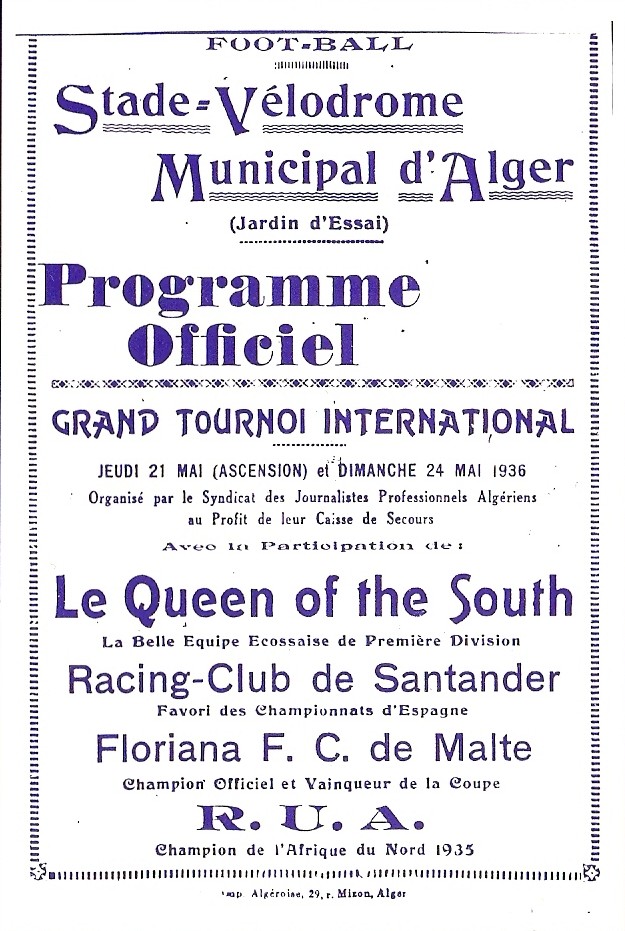
Going into the game the Santander pedigree makes impressive reading. Ever present in the eight seasons since the formation of Primera División, Santander had clocked up a second, a third and two fourth place finishes in the Spanish title contest. This included fourth place in the season that had just ended. Eye-catchingly the fourth place included home and away double victories against each of Barcelona and Real Madrid. The club has since assembled an impressive catalogue of internationalist ex players so to name only a handful; Real Madrid legends Francisco Gento, Miguel Muñoz and Santillana as well as the more currently known Yossi Benayoun and Olof Mellberg.
The physical, aggressive tactics of the Spanish side were a world away from the fluid and skilful football associated with Spain today. After Norrie Haywood put QoS in front the discipline of the Spaniards went completely. The searing heat meant ball retention was the name of the QoS game plan. However any player in possession of the ball was risking serious injury from the Spanish rough house tactics. Jackie Gordon’s on pitch involvement in the tour ended when he became victim to a broken collar bone. Joe Tulip was then ordered off but interestingly the referee appears to have been something of a pioneering zealot for the concept of a sin bin – Tulip was allowed to return 10 minutes later.
Any thoughts on reciprocation of tactics had to be reconsidered as the crowd reacted with volley after volley of projectiles aimed at QoS players. Grateful for a sports track around the pitch, Joe Tulip commented after the game that around 50 bottles had been thrown at him. With the game still in progress QoS trainer Kerr had a policemen chase him along the touchline. Despite the volatility of the scene the score stayed unchanged at QoS 1, Santander 0. And so the tournament trophy was bound for Palmerston.
The first game after a turbulent return crossing back was the only fixture of the tour played in Southern France. The match was against the side who after several name changes are today called Montpellier HSC. Another team to have made the French Cup final in the 30s (1931), like QoS they have their beginnings in 1919. Their former players now include Eric Cantona, Laurent Blanc, Didier Agathe, Laurent Robert, Franck Sauzée, Roger Milla and Carlos Valderrama. In a good game versus QoS it was the visitors who led 2-1 at half time, Joe Tulip shooting home before Ferguson yet again crossed for Cumming to finish off. A second half hand ball against Skull Allan gave the home side an equaliser before they added two more; final score Montpellier 4, Queen of the South 2.
Back to Northern France, the next opponents were Stade Reims. Reims would later dominate French football; twice European Cup finalists as well as six French titles in 14 seasons. Their great era boasts the finest strike pairing in the history of French football in Just Fontaine and Raymond Kopa. Others from the club’s great era include Michel Hidalgo. More recently Robert Pires is another ex player.
With a break from the searing heat that had prevailed from early in the tour the two sides dished up a cracker. Reims scored first before a Cumming 20 yard equaliser. Willie Anderson put QoS in front only for the home side to hit an equaliser of their own. Burns and Heywood both found the net for a half time 4 - 2 lead. Smith hit a fifth for QoS but in the face of despondency the French side were made of the right stuff. Two Reims goals added to the score-line but QoS held on for a 5-4 win.
The last game was a fixture once again versus Stade Béthunois. Haywood’s 10th minute header put QoS ahead until an early second half equaliser. Thomson’s 20 yarder put QoS ahead before appropriately tour top scorer Laurie Cumming scored the last QoS goal of the trip. Perhaps with memories of the first game fight back in their mind the host team once again scored. This time though there was to be no comeback so the tour ended with a 3-2 win for the Doonhamers.
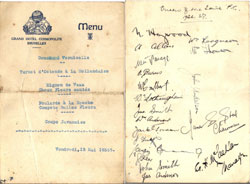
(This is a menu from a hotel QoS FC stayed in on the tour. The menu was signed by all of the playing party)
Closing summary of the tour – Thousands of miles on the clock, 11 games in 26 days, fixtures played in three countries against opponents from what are now four different nations (Algeria was a French colony at the time). 29 goals scored, 21 conceded, top scorer with nine was Laurie Cumming who also scored in the most games, seven. Jackie Gordon and Norrie Haywood each scored five goals, Willie Thomson and Joe Tulip both scored three, Burns scored two and one was scored by each of Smith and Willie Anderson. Gordon scored the only QoS hat trick, double strikes were chalked up by Haywood and Cumming (on two occasions in the case of Cumming). QoS scored in all 11 games and kept only two clean sheets themselves. One serious injury (Gordon) had been sustained and 1 player (Tulip) had a sin bin against his disciplinary record. Away from football the entourage had been sight seeing in Paris and on a sombre note visited the killing grounds of the First World War.
Players accompanying McLachlan on the tour were John Smith, Willie Fotheringham, Willie Savage, Willie Culbert, Adam Allan, John Anderson, Willie Thomson, Laurie Cumming, Willie Anderson, Joe Tulip, Jackie Gordon, Norrie Haywood, Willie Ferguson, James Anderson, Ollie Burns and Jock Smith.
It was under McLachlan the following season when QoS recorded their first victory against Rangers. In a January Scottish Cup first round tie at Palmerston McLachlan’s side deservedly went through with a 1-0 victory (featured in more detail in the Willie Savage article). QoS pushed on to make that season’s quarter finals. It was also under George McLachlan that Jackie Oakes first joined Queen of the South.
On Monday March 22nd with five games remaining of season 1936-37 the QoS board announced that McLachlan would be leaving the club on Tuesday of the following week. The week was intended to allow the out-going manager to offer advice on team building for the next season. His successor was announced as Willie Ferguson.
Once again we handover to Robert McLachlan for details of George McLachlan`s life after Palmerston.
“After Dumfries, the family went to live in Glasgow in a typical flat on Woodlands Rd c/o Willowbank st. across from Kelvingrove Park. While in Glasgow, dad maintained an interest in football by attending and reporting on a game each week, to the Sunday Post. I accompanied him to the press box a number of times.”
“Dad began a career as a Draughtsman at Babcock & Wilcox where he stayed until early 1947 when he crossed the pond to Derby, Connecticut. My sister (7 years older) who joined the WRENS in 1943, had married an American sailor and was living in New York City. Dad had responded to an ad in a Scottish newspaper posted by the Farrel Birmingham Corp. seeking draughtsmen with experience in sugar machinery (in which he had none). However he decided that, during the boat ride over the Atlantic, he could learn enough to impress his new bosses and he was right.”
“At this point, Mother and I were not happy about the move. We were living in Burnside in a very nice row house, I was involved in my first serious relationship and was the captain of the 15 & under football team at Rutherglen Academy. Mother was left with the sad chore of disposing of beautiful furniture and many of her favourite treasures accumulated over the years but we never really questioned Dad about the reasons for going.”
“Mum and I joined Dad in Derby Connecticut in Sept. 1947. I attended the local high school for one year even though it was like repeating my previous year in Rutherglen but the local kids thought I was OK so the experience became more social than educational"
"Mum and Dad were recruited by the Derby Methodist Church, (which was odd because we had not subscribed to any faith while in Scotland) and became very active. She in the choir and he eventually serving as Sunday school supervisor. Mum and Dad changed residences once over the years but it was just around the corner from the original. They purchased a summer cottage in Branford, which they really enjoyed.”
“Because of his fluency in French, acquired during his time spent in Le Havre, Dad was set to teach adult conversational French in the Branford Connecticut school system even though he had no formal education in the subject.”
“Dad was looking forward to his birthday in September when he would retire but fate dealt him a cruel blow. A nagging stomach ailment led to an exploratory operation which revealed that he had inoperable cancer. You must realize that, after football, dad remained fanatical about his physical condition and he had a hard time coping with the idea that the body that he had maintained so religiously for so long contained a cancer. Mother brought Dad to our summer cottage in Branford where she, courageously, administered ever increasing doses of morphine until he died, in September, the month in which he was born in 1902. I am really happy that he was able to spend his last few months in that pleasant environment. Mum and I scattered his ashes in the waters within sight of the cottage where she would join him twenty years later. According to my will, I’m heading there too. Just not yet!”
Previous legend Legends menu Next legend